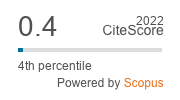Compatibility of carbosulfan 25 EC with certain agrochemicals in brinjal ecosystem
DOI:
https://doi.org/10.33307/entomon.v48i2.890Abstract
The combined use of chemical insecticides with fungicides and fertilizers in a single application is a promising pest-control option to maximise productivity and minimize labour efficiency. Studies were conducted to assess the compatibility of systemic insecticide, carbosulfan 25 EC with a fungicide, micronutrient and insecticide in brinjal ecosystem. The optimum and effective dose of carbosulfan (250 g a.i.ha-1) was compatible with other agro chemicals used in combination viz., copper oxy chloride 50 WP @500 g a.i.ha-1, zinc sulphate 0.5 per cent and dimethoate 30 EC @ 300 g a.i.ha-1, without any creaming matter and/or sediment formation in any of the combinations. The tank mix foliar application of the combination chemicals viz., carbosulfan @ 250 g a.i.ha-1 + copper oxy chloride 50 WP @ 500 g a.i.ha-1, carbosulfan @ 250 g a.i.ha-1 + zinc sulphate 0.5 per cent and carbosulfan @ 250 g a.i.ha-1 + dimethoate @ 300 g a.i.ha-1 did not inflict any phytotoxic effect on the treatment imposed plants and a mean grade of ‘1’ (0-10% injury) was awarded to all the treated plants in the brinjal ecosystem. The bioefficacy trials after two rounds of spraying with carbosulfan and combination with fertilizer and fungicides revealed that maximum per cent reduction is noticed in insecticide combination (carbosulfan @ 250 g a.i.ha-1 + dimethoate @ 300 g a.i.ha-1) as well as recommended and four times the dose of carbosulfan (250 and 1000 g a.i.ha-1), which similarly effects in managing the shoot and fruit damage caused by the shoot and fruit borer, Leucinodes orbonalis. The treatments with fertilizer and fungicides alone marked the least reduction in fruit and shoot damage. The yield of brinjal ranged from 24.1to 28.7 t ha-1 in different treatments. Plots treated with carbosulfan @ 250 g a.i.ha-1 + dimethoate @ 300 g a.i.ha-1recorded the highest fruit yield (28.7 t ha-1) followed by carbosulfan @ 250 g a.i.ha-1 + copper oxy chloride @ 500 g a.i.ha-1 (28.3 t ha-1) and carbosulfan @ 250 g a.i.ha-1+ zinc sulphate (27.8 t ha-1). The current findings states that carbosulfan in combination with other agrochemicals have given better results in terms of phytotoxicity, bioefficacy and yield.


